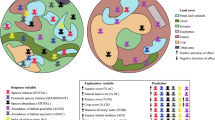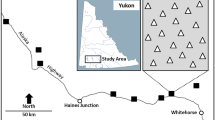Abstract
The Southern water vole, Arvicola sapidus, is endemic to the Iberian Peninsula and France. Despite being catalogued as vulnerable, our current knowledge of this species is not sufficient to establish measures for its conservation and recovery, particularly in riparian zones of Mediterranean mountain areas. The aim of this study was to identify factors related to habitat configuration that determine the presence or absence of the species in the Montsant River. Specifically, we associated the presence/absence of this arvicolid rodent with composition of vegetation, river bank morphology, and watercourse characteristics. The results suggest that, in this area, the most favorable places for the species are those with a high degree of cover of herbaceous plants (mainly helophytes) and moderate to low levels of tree and shrub cover; gently sloping banks and a soft substrate; and the presence of water, with moderate to high stream widths and depths. In addition, we developed a classification method which allowed us to classify and characterize habitat conditions: the optimal scenario (preferential for arvicoline establishment), the suboptimal scenario (whose use is related to opportunities to find best scenarios), and the hostile scenario (not acceptable for use). In such riparian areas, the results revealed that the Southern water vole is a specialist in terms of habitat selection, but behaves as a generalist in terms of occupancy. Its ability to adapt to suboptimal conditions widens the options for managing Southern water vole populations, and indicates that the maintenance and rehabilitation of habitat along continuous stretches of river is the most effective approach to achieving self-sustaining populations.



Similar content being viewed by others
References
Barreto GR, Rushton SP, Strachan R, Macdonald DW (1998) The role of habitat and mink predation in determining the status and distribution of water voles in England. Anim Conserv 1:129–137. doi:10.1111/j.1469-1795.1998.tb00020.x
Barrull J, Mate I (2007) Fauna Vertebrada del Parc Natural de la Serra de Montsant. Diputació de Tarragona, Tarragona
Bonesi L, Rushton S, Macdonald D (2002) The combined effect of environmental factors and neighbouring populations on the distribution and abundance of Arvicola terrestris. An approach using rule-based models. Oikos 99:220–230. doi:10.1034/j.1600-0706.2002.990202.x
Cabrera A (1914) Fauna Ibérica. Mamíferos. Museo Nacional de Ciencias Naturales, Madrid
Carter SP, Bright PW (2003) Reedbeds as refuges for water voles (Arvicola terrestris) from predation by introduced mink (Mustela vison). Biol Conserv 111:371–376. doi:10.1016/S0006-3207(02)00305-1
Collen B, McRae L, Deinet S, De Palma A, Carranza T, Cooper N, Loh J, Baillie JEM (2011) Predicting how populations decline to extinction. Phil Trans R Soc B 366(1577):2577–2586. doi:10.1098/rstb.2011.0015
CWC (2005) The ecology and conservation of water voles in upland habitats. Scottish Natural Heritage Commissioned Report No. 099
Delibes M (2002) Infraestructuras, hábitats y biodiversidad. I Congreso de Ingenieria Civil, Territorio y Medio Ambiente (ICITEMA). Ponencias y Comunicaciones 1:173–190
Fedriani JM, Delibes M, Ferreras P, Román J (2002) Local and landscape habitat determinants of water vole distribution in a patchy Mediterranean environment. Ecoscience 9:12–19
Garde JM (1992) Biología de la rata de agua Arvicola sapidus Miller, 1908 (Rodentia, Arvicolidae) en el sur de Navarra (España). PhD dissertation. University of Navarra
Garde JM, Escala MC (1993) Situación actual de la rata de agua Arvicola sapidus Miller, 1908 (Rodentia, Arvicolidae) en Navarra. Revista del Centro de Estudios Merindad de Tudela 5:121–130
Garde JM, Escala MC (1996) Reproductive cycle of Arvicola sapidus (Rodentia, Arvicolidae) from southern Navarre, Spain. Acta Theriol 41:353–365
Garde JM, Escala MC (2000) The diet of the southern water vole, Arvicola sapidus in southern Navarra (Spain). Folia Zool 49:287–293
Gosàlbez J (1987) Insectívors i Rosegadors de Catalunya. Metodologia d’estudi i Catàleg faunístic. Ketres editora, Barcelona
Graells MP (1897) Fauna Mastodológica Ibérica. Memorias de la Real Academia de Ciencias Exactas. Físicas y Naturales XVII, Madrid
Gregory SV, Swanson FJ, McKee WA, Cummings KW (1991) An ecosystem perspective of riparian zones. Bioscience 41:540–551
Gromov IM, Polyakov IYa (1992) Fauna of the USSR. Mammals. Vol. III. No. 8. Voles (Microtinae). Brill, Leiden
Jennings SB, Brown ND, Sheil D (1991) Assessing forest canopies and undestorey illumination: canopy closure, canopy cover and other measures. Forestry 72:59–73. doi:10.1093/forestry/72.1.59
Kennedy KA, Addison PA (1987) Some considerations for the use of visual estimates of plant cover in biomonitoring. J Ecol 75:151–157
Kercher SM, Frieswyk CB, Zedler JB (2003) Effects of sampling teams and estimation methods on the assessment of plant cover. J Veg Sci 14:899–906. doi:10.1111/j.1654-1103.2003.tb02223.x
King C (1985) Interactions between woodland rodents and their predators. Symp Zool Soc Lond 55:219–247
Lawton JH, Woodroffe GL (1991) Habitat and the distribution of water voles: why are there gaps in a species’ range? J Anim Ecol 60:79–91
Luscier JD, Thompson WL, Wilson JM, Gorham BE, Dragut LD (2006) Using digital photographs and object-based image analysis to estimate percent ground cover in vegetation plots. Front Ecol Environ 4:408–413. doi:10.1890/1540-9295(2006)4[408:UDPAOI]2.0.CO;2
Mate I, Barrull J (2008) La rata d’aigua, Arvicola sapidus, al Parc Natural de la Serra de Montsant. I. Distribució i estima poblacional. Parc Natural de la Serra de Montsant, Dep. Medi Ambient i Habitatge, Generalitat de Catalunya. CDMA1300054085. Unpublished report
Mate I, Barrull J (2010) Primera cita de visón americano (Neovison vison Schreber, 1777) en el río Montsant (Tarragona). Galemys 22:63–65
Morris DW (1987) Tests of density-dependent habitat selection in a patchy environment. Ecol Monogr 57:269–281
Morris DW (2003) Toward an ecological synthesis: a case for habitat selection. Oecologia 136:1–13. doi:10.1007/s00442-003-1241-4
Morris PA, Morris MJ, Macpherson D, Jefferies DJ, Strachan R, Woodroffe GL (1998) Estimating numbers of the water vole Arvicola terrestris: a correction to the published method. J Zool 246:61–62. doi:10.1111/j.1469-7998.1998.tb00132.x
Orians GH, Wittenberger JF (1991) Spatial and temporal scales in habitat selection. Am Nat 137:29–49
Orta J, Ruiz-Olmo J (1987) Estudi sobre l’embassament de Margalef al riu Montsant. Part I: Estudi de l’impacte sobre els sistemes naturals. Servei de Protecció de la Natura, Direcció General de Política Forestal del DARP, Generalitat de Catalunya, Barcelona. Unpublished report
Pascual R (2007) Flora de la serra de Montsant. Vol 1. Ed. Rafael Dalmau, Barcelona
Pita R, Mira A, Beja P (2010) Spatial segregation of two vole species (Arvicola sapidus and Microtus cabrerae) within habitat patches in a highly fragmented farmland landscape. Eur J Wildl Res 56:651–662. doi:10.1007/s10344-009-0360-6
Pita R, Mira A, Beja P (2011) Assessing habitat differentiation between coexisting species: the role of spatial scale. Acta Oecol 37:124–132. doi:10.1016/j.actao.2011.01.006
Prenda J, Granado-Lorencio C (1996) The relative influence of riparian habitat structure and fish availability on otter Lutra lutra L. sprainting activity in a small Mediterranean catchment. Biol Conserv 76:9–15. doi:10.1016/0006-3207(95)00080-1
Rigaux P, Vaslin M, Noblet JF, Amori G, Muñoz LJP (2008) Arvicola sapidus. In: IUCN 2010. IUCN Red List of Threatened Species. Version 2010.4. http://www.iucnredlist.org. Accessed 26 March 2011
Rigaux P, Chalbos M, Auvity F, Braure E, Trouillet S (2009) Élements sur la densité locale et l’utilisation de l’espace du campagnol amphibie (Arvicola sapidus): exemple de trois sites en Auvergne. Rapport d’étude. Groupe Mammalogique d’Auvergne. Unpublished report
Román J (2003) Guía de indicios de los mamíferos. Rata de agua Arvicola sapidus Miller 1908. Galemys 15:55–59
Román J (2007) Historia natural de la rata de agua Arvicola sapidus en Doñana. PhD dissertation. Autonomous University of Madrid, Madrid
Saint-Girons MC (1973) Les mammifères de France et du Benelux (faune marine exceptée). Doin, Paris
Saucy F (1999) Arvicola sapidus Miller, 1908. In: Mitchell-Jones AJ, Amori G, Bogdanowicz W, Kryštufek B, Reijnders PJH, Spitzenberger F, Stubbe M, Thissen JBM, Vohralík V, Zima J (eds) The atlas of European mammals. Academic, London, pp 220–221
Sedell JR, Reeves GH, Hauer FR, Stanford JA, Hawkins CP (1990) Role of refugia in recovery from disturbances: modern fragmented and disconnected river systems. Environ Manage 14:711–724
Shaffer ML (1981) Minimum population sizes for species conservation. Bioscience 31:131–134
Sykes JM, Horrill AD, Mountford MD (1983) Use of visual cover assessments as quantitative estimators of some British woodland taxa. J Ecol 71:437–450
Vanha-Majamaa I, Salemaa M, Tuominen SM, Mikkola K (2000) Digitized photographs in vegetation analysis—a comparison of cover estimates. Appl Veg Sci 3:89–94. doi:10.2307/1478922
Ventura J (2007) Arvicola sapidus Miller, 1908. Rata de agua. In: Palomo LJ, Gisbert J, Blanco JC (eds) Atlas y Libro Rojo de los Mamíferos terrestres de España, Dirección General para la Biodiversidad. MIMAM, SECEM, SECEMU, Madrid, pp 405–407
Ventura J, Gosàlbez J, López-Fuster MJ (1989) Trophic ecology of Arvicola sapidus Miller, 1908 (Rodentia, Arvicolidae) in the Ebro Delta (Spain). Zool Anz 223:283–290
Waterman J (2007) Male mating strategies in rodents. In: Wolff JO, Sherman PW (eds) Rodent societies. An ecological & evolutionary perspective. The University of Chicago Press, Chicago, pp 27–41
Waters JR, Zabel CJ, McKelvey KS, Welsh HH Jr (2001) Vegetation patterns and abundances of amphibians and small mammals along small streams in a Northwestern California watershed. Northwest Sci 75:37–52
Westoby M, Leishman M, Lord J (1996) Comparative ecology of seed size and dispersal [and discussion]. Philos Trans R Soc London [Biol] 351:1309–1318. doi:10.1098/rstb.1996.0114
Woodall PF (1993) Dispersion and habitat preference of the Water vole (Arvicola terrestris) on the River Thames. Z Säugetierkd 58:160–171
Acknowledgments
The authors would like to thank J. Palet and A. Segrove for their assistance with the fieldwork, and the two anonymous reviewers for their valuable suggestions. I. Mate would like to thank the medical staff of the Neuroradiology Units of Hospital Clínic and Hospital de la Santa Creu i Sant Pau, Barcelona, and especially Dr. A. Tomasello, for their extraordinary professional work and humanity.
Author information
Authors and Affiliations
Corresponding author
Additional information
Communicated by: Karol Zub
Rights and permissions
About this article
Cite this article
Mate, I., Barrull, J., Salicrú, M. et al. Habitat selection by Southern water vole (Arvicola sapidus) in riparian environments of Mediterranean mountain areas: a conservation tool for the species. Acta Theriol 58, 25–37 (2013). https://doi.org/10.1007/s13364-012-0090-0
Received:
Accepted:
Published:
Issue Date:
DOI: https://doi.org/10.1007/s13364-012-0090-0




